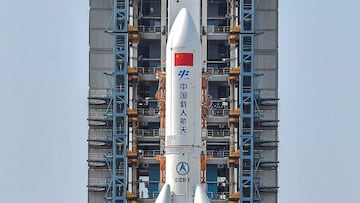Chinese Rocket: when and where will it fall to earth?
In space, there is little room for error… A message that has become clear as remnants from an uncontrolled Chinese rocket are tumbling towards earth.


When a rocket is launched into space, there are various ways the leftover material can reenter the earth’s orbit to land. Some are sent into the ocean to avoid collisions on land, while others are manned back to a space station on earth.
This week China launched its largest rocket to date into space to deliver materials in equipment needed to build its new space station. The space station, which is expected to become operational in 2022, received its cargo successfully, after which the remaining materials began their uncontrolled fall to earth.
Why is the rocket falling to earth?
In most cases, after a rocket has dropped off supplies, the engine is rebooted, and coordinates for its return are determined. These coordinates are usually in the middle of the ocean to avoid a land collision. The Chinese have not been known to use this practice and in a statement defending their reentry procedures, the Chinese Foreign Ministry stated that “The probability of this process causing harm on the ground is extremely low,” as much of the material will burn off as it reenters the earth’s atmosphere.
This approach has been criticized by Harvard astrophysicist Jonathan McDowell who stated that "China decided they would rather use a simpler design and hope that they get lucky with the stage re-entering uncontrolled but not hurting anyone."
Predictions for when and where Chinese rocket debris hurtling toward Earth is expected to land are narrowing. https://t.co/VpIkPz9bsP
— ABC News (@ABC) May 8, 2021
Where is the rocket expected to land?
While the thought of waking up to the sound of a 23-ton rocket crash landing in your backyard is horrifying, the odds are improbable. Considering that over 70% of the earth’s surface is covered by the ocean, it is the most probable place it will land.
Complicating matters, however, is that most scientists believe the true trajectory of the space debris cannot be estimated until hours of its expected landing.
Related stories
McDowell, who is following the rocket’s trajectory, has said that New York City or Madrid could see pieces of debris as well as cities and countries further south, including Chile and New Zealand.
The Aerospace Corporation, a space research and innovation center, has been tracking where they believe the debris will land. Currently, they place it in the middle of the Atlantic Ocean.
NEW Our latest prediction for #LongMarch5B CZ-5B rocket body reentry is 🚀 09 MAY 2021 03:26 ± 2 hours along the ground track shown here. 1/ pic.twitter.com/Jn4A4IJQAD
— The Aerospace Corporation (@AerospaceCorp) May 8, 2021

